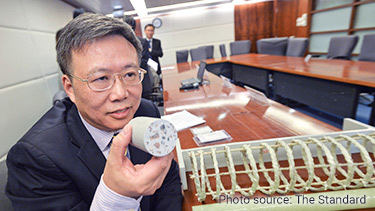Marine Infrastructure

Sponsored by

Sponsored by

Marine Infrastructure
Developing Sustainable Marine Infrastructure

Another example of such cutting-edge research is the project led by President Teng, who is a distinguished scholar in the field of structural engineering, which seeks to achieve more sustainable infrastructure in coastal regions. The project, to be completed by December 2024, is supported by a grant of over $6.6 million (HK$52 million).
Another example of such cutting-edge research is the project led by President Teng, who is a distinguished scholar in the field of structural engineering, which seeks to achieve more sustainable infrastructure in coastal regions. The project, to be completed by December 2024, is supported by a grant of over $6.6 million (HK$52 million).
Coastal cities like Hong Kong rely heavily on ports, bridges, artificial islands, offshore wind farms, and other coastal and marine infrastructure for social-economic development. Many of these structures are constructed with steel or concrete reinforced with steel. In a marine environment, steel without proper protection corrodes quickly, leading to severe deterioration of the structure. Steel corrosion typically costs an economy around 3% of its gross domestic product, or in Hong Kong’s case, in 2018, around $10.8 billion (HK$85 billion).
A very promising solution to the steel corrosion problem in marine reinforced concrete structures is to replace steel with corrosion-resistant fiber-reinforced polymer (FRP) as the reinforcing material. Once FRP is used, seawater and sea sand, which cannot be used in concrete structures with steel reinforcement, can be directly employed to make the seawater sea-sand concrete (SSC). This innovative concept, proposed by President Teng, is especially attractive for the development of marine infrastructure on islands and in other locations where there is a shortage of fresh water and river sand. The FRP-SSC structural technology is expected to be a major breakthrough in the construction of marine infrastructure as it will greatly extend its lifespan and, at the same time, help protect the natural environment.
The inter-disciplinary research team includes members from both local and overseas universities. These include the City University of Hong Kong, City, University of London, Delft University of Technology, the Hong Kong University of Science and Technology, Massachusetts Institute of Technology, the University of Hong Kong, the University of Illinois Urbana-Champaign, the University of Macau and Vanderbilt University. Together, the scientists are developing new structural forms that take advantage of the strengths of both FRP and SSC, and examining in depth the behavior of these structures. In so doing, they are aiming to establish new methods for design, construction and performance monitoring that would allow this new type of structures to be widely used. A key challenge for the team is the establishment of a multi-scale, multi-physics approach for predicting the long-term performance of these structures.
“These structures will revolutionize the construction of marine infrastructure,” says President Teng, adding that “great environmental and economic benefits can be derived not only for Hong Kong, but also for the nation and the whole world.”